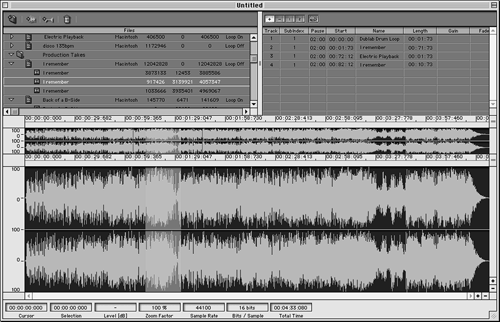INSTALLATION
Spark requires a Power Macintosh with a 604 processor running at 133 MHz or better, and 64 MB of memory. I tested Spark version 1.01 on a Power Mac 8600 running at 300 MHz, with 128 MB total memory. The program takes up a bit over 12 MB of hard disk space, including the plug-ins. Although the manual says Spark requires Mac OS 8.1 or higher, I tested it with Mac OS 7.6.1 plus the Appearance Manager extensions with no ill effects.
An installer program on the Spark CD walks you through the process, including authorizing the program by means of a floppy key disk. Yes, Spark is copy-protected. You get one authorization on the key disk. Once authorized, the program will run without the floppy, but hard disks crash and floppy disks become unreadable. Given the fact that the software ships on a CD offering some protection against piracy, perhaps TC Works will see fit to remove the copy protection at some future date.
Spark is organized into just two main windows, a welcome relief from the jumble of multiple windows presented by other products. The Browser View contains a database of audio clips, the Waveform Editor, the Playlist, and the Transport Controls. The Master View handles all the real time plug-ins, plus mixing. It’s all well thought-out and simple, even without the 53 page manual.

THE BROWSER VIEW
The Browser is the main view for the recorder and editor sections of Spark, and takes up the most screen space. A list of files occupies the upper left portion of the window, while the upper right part shows the current Playlist. Icons above these let you add and delete files, get info about a file or region, and save files to disk. Spark can open and save .wav, .aiff, and QuickTime audio files, so you should have no problems working on sound files generated by other programs.
The Playlist is most flexible. You can drag a region from the waveform directly into the Playlist, and drag parts from one position in the list to another. You can adjust the crossfade between parts, select from seven different crossfade types, and set the length of the crossfade. Moreover, with one click you can export your finished Playlist as an image file that will open directly in Toast, where you can burn a finished CD. Quick and slick.
The bottom half of the Browser View displays the waveform in mono or stereo. On the top is an overview that shows the entire file’s waveform, and below that is the editing view which can be zoomed in or out in either direction. In both, time is displayed in the units you’ve set via the Preferences menu. I prefer to work in the film-style HH:MM:SS:msec view, but you can also work in sample frames, seconds, or milliseconds only.

There’s also a Transport window, which has not only the standard Transport Controls but also a loop button and time display. To the left of the Transport Controls is a display showing the active sampling rate, a resampling rate indicator, and the current I/O setup. To the left of the Transport Controls is a jog/shuttle wheel that allows real time audio scrubbing, time-stretch and vari-speed. The time-stretch function on the Transport window is a real time process, so you can hear the results immediately.
Spark’s standard File and Edit menus contain what you’d expect. Additional menus include one labeled Process, which lets you access some offline DSP functions including Fade, Change Gain, Normalize, Reverse, Invert, DC Removal, Resample, Time Stretch, and Pitch Shift.

